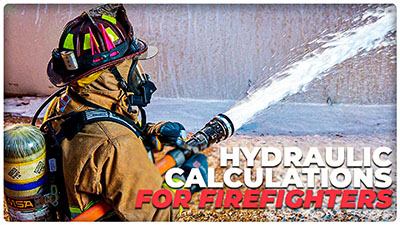Hydraulic Calculations Every Firefighter Needs to Know
Firefighting involves a little bit of math from time to time. From figuring out pump discharge pressure to nozzle reaction, there are some formulas and equations you need to be familiar with.
Let’s explore what some of these formulas are:
Fire Flow
When calculating the flow necessary to extinguish a fire, there are two equations that are commonly used in the fire service. The Iowa Fire Flow formula is designed for achieving fire control, not extinguishment for the single largest open area of the building. The National Fire Academy (NFA) formula is based on offensive interior operations where ceiling height is no greater than 10ft. Both formulas will help you find an approximate needed fire flow during pre-planning, though they will produce slightly different results.
- Iowa Fire Flow: Required Volume = (length X width X height) / 100
- NFA Fire Flow: Needed Flow = [(Length X Width) / 3] X percent of involvement
In these formulas, the length, width, and height are for the involved structure and expressed in feet.
You can also reference NFPA 1710 (2020 edition) for their recommended standards for fire suppression on initial full alarm assignments. They include the following:
- Single family dwelling: 300 GPM from two handlines each of which has a minimum flow rate of 100 GPM
- Open Air Strip Shopping Center: 500 GPM from two handlines each of which has a minimum flow rate of 150 GPM
- Apartment: 300 GPM from two handlines each of which has a minimum flow rate of 100 GPM
- High-Rise: Minimum 500 GPM on the fire floor from two handlines and a minimum of 250 GPM on the floor above the fire from at least one handline
Fog Nozzle Reaction
The fog nozzle reaction formula can be used to calculate the amount of nozzle reaction you will experience at a given flow rate and nozzle pressure.
NR = .0505 X GPM X √NP
NR: Nozzle Reaction in pounds of force
NP: Nozzle Inlet Pressure in PSI
Friction Loss Formula
The friction loss formula allows you to calculate the friction loss you experience from the pump to the nozzle. This number affects the pump discharge pressure needed to achieve your desired flow rate.
FL = friction loss coefficient X (flow rate / 100)2 X (hose length / 100)
OR
FL = C(Q/100)2 X (L/100).
FL: Friction Loss in PSI
Flow Rate: in GPM
Hose length: in feet
Pump Discharge Pressure
Pump Discharge Pressure, or PDP, is calculated so that you can properly pump your hose and nozzle combination to achieve your target flow rate. Improperly setting your PDP can cause you to over or under pump a nozzle, which affects flow rate, nozzle reaction, and stream reach.
PDP = NP + FL
Some equations factor in appliances and elevation using PDP = NP + FL + Appliance Loss + Elevation Loss
NP: Nozzle Pressure in PSI
FL: Friction Loss in PSI
Relay Pumping
The relay pumping formula allows you to calculate the PDP required for the attack engine in a relay pumping operation.
PDP = FL + 20
Twenty is an estimated value that represents the minimum amount of pressure (PSI) at the intake of the next pumper. Some departments may choose to use a higher pressure than 20 PSI.
PDP: Pump Discharge Pressure in PSI
FL: Friction Loss in PSI
Smooth Bore GPM
The smooth bore GPM formula helps you calculate the GPM of a smooth bore based on a constant, the diameter of your nozzle opening, and the nozzle exit pressure.
GPM = 29.7 X D² X √NP
D: Diameter of Nozzle Opening in inches
NP: Nozzle Exit Pressure measured with a handheld pitot in PSI
Smooth Bore Nozzle Reaction
This formula gives you the ability to calculate the nozzle reaction you will experience for a given exit pressure of a smooth bore.
NR = 1.57 x D² x NP
D: Diameter of Nozzle Opening in inches
NP: Nozzle Exit Pressure measured by handheld pitot (PSI)
NR: Nozzle Reaction in pounds of force
